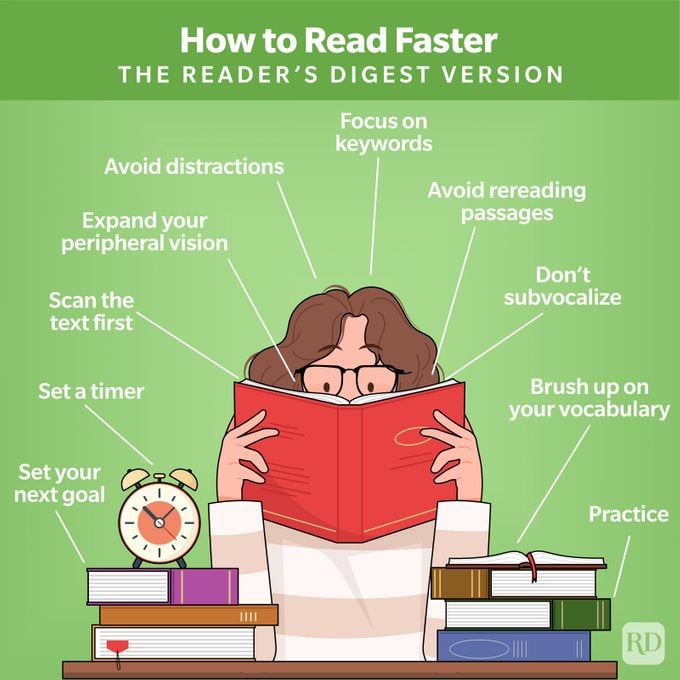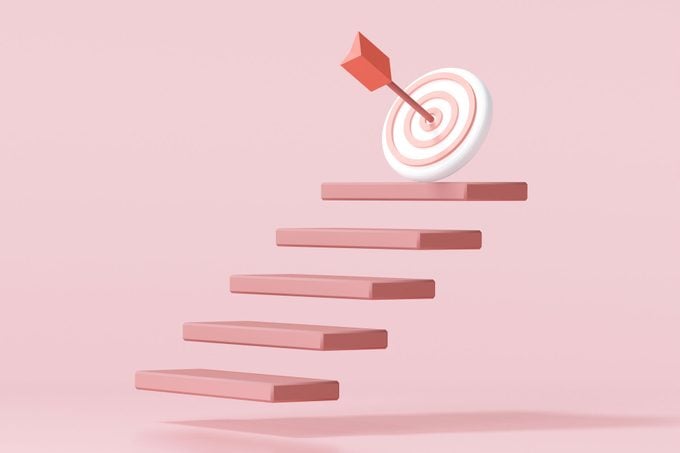How to Read Faster—and Understand What You’ve Read
Updated: Apr. 16, 2024

For the days when time is not on your side, here's how to read faster without missing a thing
Thrillers and romance and mystery, oh my! There are almost too many great books to read in a lifetime, and as someone with a massive to-be-read lineup, I sometimes wish I could flip the pages with a little more speed. If you’re also wondering how to read faster, you’re in luck.
I spoke to two experts about how to speed read to get through more books and articles—without sacrificing comprehension, so you can still soak up all those great benefits of reading. These aren’t suggestions for becoming a bona fide speed reader (that requires you to read 700 words per minute—yikes!). Instead, we’re looking for tried-and-true ways to help you finish more of the best books in your standard reading time slot. Ultimately, reading faster could also help you learn something new every day.
Join the free Reader’s Digest Book Club for great reads, monthly discussions, author Q&As and a community of book lovers.
Fast readers have all the fun
“Reading faster isn’t just about impressing your book club with your page-turning prowess,” says Diana Anson, LCSW, wellness director at Insight Therapy Solutions. “In our information-saturated world, the ability to devour text swiftly is like having a mental jetpack.”
In other words, knowing how to read faster is kind of like a hidden superpower. Fast readers can stay on top of the latest news and trends and improve productivity at work or school. In other words, fast reading helps you gain more knowledge in less time, says speech pathologist Hollie Fleming.
Of course, simply reading faster doesn’t mean you’re smarter. Plenty of intelligent people like to take their time savoring a great work of fiction or slowly tucking away facts from research articles. But whether you choose to read quickly all the time or only when you’re in a pinch, knowing how to read fast while still understanding what you’re reading is a valuable skill.
The downside of speeding through your reading
Yes, reading fast has its benefits. But if you’re not careful, Anson and Fleming say too much speed can defeat the purpose of reading: comprehension.
Rushing through a great book might not give your brain a chance to process the story. Speeding through text can make you miss out on more subtle concepts, says Fleming. That might mean missing an important clue in an Agatha Christie mystery or a critical step in a how-to article.
In the end, speed works better for some types of reading than others. “Imagine trying to speed-read a soufflé recipe and ending up with scrambled eggs,” says Anson.
How to read faster
Remember, you don’t have to become a full-fledged speed reader to reap the benefits of faster reading. Here are Anson and Fleming’s top tips for how to read faster—and understand what you read.

1. Avoid distractions
What’s the difference between curling up with a book in a quiet house and cracking open a new novel while sitting in the bleachers at a raucous high school basketball game? Your environment, of course. That, and your ability to focus.
Fleming’s No. 1 tip for reading faster is addressing environmental distractions. “Reducing sounds and sights in your environment gives your brain more energy to focus on the written material,” she explains.
So next time you want to tackle your TBR pile or catch up on required reading before class, head to a quiet place. Libraries are an ideal reading environment, but even a corner table at a busy cafe can work if you face away from the action and put on some noise-canceling headphones.
2. Scan the text first
“Before you embark on the speed-reading adventure, give the text a quick scan,” says Anson. “Look for headings, subheadings, bolded text and any visual cue that offers a roadmap.”
By giving your brain a preview of the topic, she says, you reduce time spent processing surprise information. The result is a faster reading time.
This tip mainly applies to academic texts, but it can be a helpful strategy for any factual or how-to piece, from nonfiction books to news articles. In fact, you’ll spot headings and subheadings in this article, guiding you on your faster-reading journey.
3. Focus on keywords
This tip for faster reading is directly related to the last one. When scanning the text (sometimes called pre-reading), Fleming suggests focusing on keywords. These are the words or phrases most relevant to the overall purpose of the piece.
“By mentally or physically highlighting keywords, you create a framework in your brain to store, remember and understand information,” she explains.
Let’s say you’ve picked up an article about how to read people through their body language. You might quickly scan the text and highlight specific examples of body language: smiling, frowning, eye contact or particular postures. Now that you’ve scanned and highlighted the keywords, you know exactly which types of body language you’ll be learning to read. Giving your brain a quick preview like this will help you fly through the article more quickly, all without sacrificing comprehension.
4. Set a timer

You’ve found a quiet place, scanned the text and pinpointed keywords. Now what? Set a timer and start reading!
The simple act of setting a timer helps set the stage for focused reading time. And the more focused you are, the faster you can read and, importantly, remember things you read.
Fleming suggests starting with shorter periods versus long reading sessions, especially if you want to hone the skill of fast reading. Begin by setting a timer for just five minutes and committing to nonstop reading until the timer rings. This will help you train your brain to stay focused entirely on the task at hand—reading!
5. Expand your peripheral vision
When children learn to read, we often teach them to focus on the structure of just one word at a time. But as your reading skills stretch and grow, you should expand your reading snapshots to include your peripheral vision.
So, what exactly does that mean?
“Ever wonder why you can spot the last piece of cake disappearing at a party, even when you’re not looking directly at it? It’s your peripheral vision working its magic,” says Anson. “Apply the same principle to reading. Train your eyes to capture groups of words in a single glance. Your brain is a pattern-detecting powerhouse—let it flex those muscles.”
6. Silence your inner subvocalizer
Subvocalizing is the act of silently saying words in your head as you read. It means you are taking the time to read each word and “hear” it in your head as dialogue or monologue. Subvocalizing is a handy way to ensure you understand what you read, but it’s also a habit that can slow you down.
One of Anson’s top tips for reading faster is to put your inner voice on vacation. She says mentally voicing the words you read can be a major roadblock to speed. Instead of silently mouthing or imagining each word, she suggests training your brain to process chunks of words—”or even full phrases at a time.”
7. Avoid rereading passages
Sometimes rereading is necessary for comprehension, but it’s best to avoid backtracking when the timer is set and you’re trying to read faster. So as you finesse the art of fast reading, try to avoid returning to reread certain passages or pages.
Avoiding rereading won’t increase your IQ, but it will accomplish two other things: It improves your words-per-minute rate now. It also trains your brain to pay closer attention in the future, since you’re not allowing yourself the luxury of paging backward for information.
8. Set your next goal

“Think of reading like a workout,” says Anson. “Set aside specific chunks of time—let’s call them reading sprints—and challenge yourself to read as fast as you can. This isn’t about breaking speed records; it’s about building your reading stamina over time.”
In other words, don’t put the timer away after using it once. After your first timed reading session is over, schedule the next one. Maybe you want to read for 20 uninterrupted minutes per day. Can you get through one more page today than you did yesterday?
Remember, you don’t need to reach speed-reader status. If you have a lofty goal to read 400 pages in a day, for instance, you can probably reach it—but it will take a lot of time. The average reader takes about 11 hours to read 400 pages, so even speedy readers can expect to spend hours finishing those pages. Your goal is simply to get a little faster each day, building speed and skill for the long haul.
9. Brush up on your vocab
Have you ever been deeply immersed in a story only to stop short at a word you don’t recognize? The stronger your vocabulary, the slimmer your chances of slowing down to puzzle over the meaning of a word. You can brush up with vocabulary quizzes or use these smart tactics to improve your vocabulary.
Reading outside your usual genres and topics helps too: Reading news articles from the economics section can help you learn new financial terms. And reading nonfiction health books can help you pick up medical vocabulary terms you might not see otherwise.
10. Practice, practice, practice
If you want to learn how to read faster, the best thing you can do is read frequently. Read for fun. Read for entertainment. Read for understanding. Read on vacation, on the train, at the doctor’s office, in the bathtub … just read, read, read whenever you have a spare moment.
“The more you read, the better your brain gets at reading,” says Fleming.
And remember: It’s a skill that takes time to master. “Becoming a speed reader is like learning to salsa dance,” adds Anson. “Start slow, find your rhythm, and soon you’ll be breezing through pages like a literary Zorro!”
Get Reader’s Digest’s Read Up newsletter for more knowledge, books, humor, cleaning, travel, tech and fun facts all week long.
About the experts
- Diana Anson, LCSW, is an experienced psychotherapist who has held several leadership roles in her career with Insight Therapy Solutions in Las Vegas. She also spent 30 years as a professor of psychology at the College of Southern Nevada.
- Hollie Fleming, MS, CCC-SLP, has been a speech-language pathologist for more than 16 years. An expert on the relationship between language and reading, she serves on the board of directors for the Nevada Speech Language and Hearing Association.
Sources:



